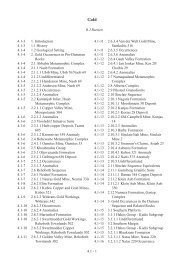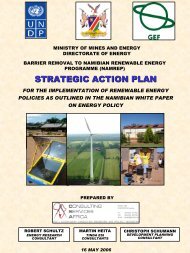Solar PV water pumping study - FINAL REPORT ... - UNDP, Namibia
Solar PV water pumping study - FINAL REPORT ... - UNDP, Namibia
Solar PV water pumping study - FINAL REPORT ... - UNDP, Namibia
Create successful ePaper yourself
Turn your PDF publications into a flip-book with our unique Google optimized e-Paper software.
Feasibility Assessment for the Replacement of Diesel Pumps with <strong>Solar</strong> Pumps<br />
Table 3.2: Transport rates<br />
Transport type<br />
<strong>FINAL</strong> <strong>REPORT</strong>: September 2006<br />
Rate<br />
[N$/km]<br />
Truck 9.00<br />
Contractor bakkie 5.00<br />
Local vehicle 3.00<br />
Furthermore there are three distances that are referred to in the calculations. These are:<br />
1. Installation distance: The distance from a larger centre (e.g. Windhoek) to site. It is<br />
assumed that the hardware is stocked at that centre. The default distance is 300km<br />
one way.<br />
2. Service distance: The distance from the diesel pump installation to the fuel and diesel<br />
engine service infrastructure. The default distance is 100km one way.<br />
3. Operator distance: The distance between the operator (farmer) and a remotely<br />
located diesel pump. This distance is only applicable to the commercial farmers as it<br />
is assumed that the community is always in the immediate vicinity of the installation.<br />
The default distance is 3km one way.<br />
3.1.4.1 Capital cost<br />
The capital costs occur once at the beginning of the project. It comprises the cost of the<br />
equipment and accessories, the cost of the installation and the cost of transport. The cost<br />
includes all the accessories up to the exit of the borehole. No pipe extensions, reservoirs or<br />
pump house structure are included. In the case of <strong>PV</strong>Ps a dual pump solution can be<br />
selected for the Grundfos. This assumes that the borehole is able to accommodate such an<br />
installation which exceeds the normal 3 to 4 inch installation diameter of <strong>PV</strong>Ps. The capital<br />
costs are nearly doubled in this case as there are only savings on transport and some minor<br />
savings on piping if the two pumps feed into the same pipe.<br />
It is assumed that the transport vehicle for a <strong>PV</strong>P installation is a bakkie (N$ 5/km at current<br />
fuel prices) whereas the transport vehicle for a diesel installation is a truck (N$ 9/km at<br />
current fuel prices) due to the weight of installation materials. It is assumed that the distance<br />
to site for the installation trip is 300km.<br />
In terms of the DRWS vs. Private system, the main difference is that the DRWS<br />
specifications are fairly high and would thus not be a true cost reflection of a private<br />
installation. Therefore certain initial cost items are reduced assuming that the commercial<br />
farmer will do some of that work at a lower cost (accessories for installation, foundation<br />
costs, belt guard, installation cost, transport cost) when the private installation type is<br />
selected.<br />
The capital costs used in the calculations form part of the spreadsheet database and are<br />
listed in the Appendix A2.<br />
3.1.4.2 Operating cost<br />
The operating costs for a DRWS installation are only applicable to the diesel <strong>pumping</strong><br />
system. The operator costs (person starting the diesel engine, person looking after the <strong>PV</strong>P<br />
system) are ignored for both the diesel as well as the <strong>PV</strong>P installation.<br />
Page 19 of 76




